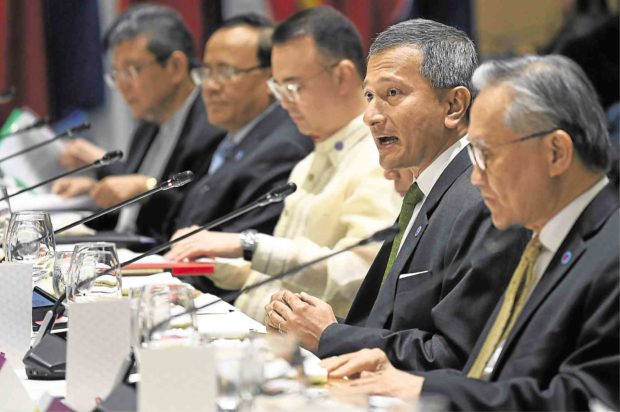China seeks military drills with Asean in disputed sea

MINISTERS’ MEET Foreign Secretary Alan Peter Cayetano (center) of the Philippines joins his counterparts (from left) Saifuddin Abdullah of Malaysia, U Kyaw Tin of Myanmar, Vivian Balakrishnan of Singapore and Don Pramudwinai of Thailand during the Association of Southeast Asian Nations ministerial meeting in Singapore on Wednesday. —AFP
SINGAPORE—China wants military exercises and energy exploration with Southeast Asian nations in disputed waters, according to a draft document, but it insists on outside countries being excluded in what analysts said was a bid to diminish US influence.
Beijing’s suggestions are part of efforts to expand its influence in the South China Sea, which it claims almost entirely, and push back at Washington, which has backed countries with overlapping claims to the waterway.
A code of conduct between Beijing and the Association of Southeast Asian Nations (Asean) to govern behavior in the strategic sea has been years in the making.
Bargaining positions
The draft document, seen by Agence France-Presse (AFP), outlines different countries’ bargaining positions as they work toward an agreement, and analysts said it represented some initial progress.
Article continues after this advertisementIn the text, Vietnam offers the strongest opposition to Beijing’s activities calling for countries to stop building artificial islands and establishing military installations.
Article continues after this advertisementBut there was little sign of serious resistance from other countries, signaling how opposition to China’s aggressive expansion in the resource-rich waters has ebbed in recent years in Southeast Asia.
Brunei, Malaysia, the Philippines, Taiwan and Vietnam have rival claims to China’s in the South China Sea.
Tensions have escalated in recent years due to Beijing building artificial islands that can host military bases.
The United States—traditionally the dominant military power in the area—has more frequently carried out patrols aimed at ensuring freedom of navigation.
Long-running tensions
In the draft text, Beijing suggests that China and the 10 Asean states should carry out joint military exercises regularly.
But the drills should not involve countries outside the region “unless the parties concerned are notified beforehand and express no objection.”
The suggestion to exclude outside countries “is obviously targeted at the US, which has been dominating the waters of the Western Pacific and the South China Sea in particular,” Hoang Thi Ha, from the Asean Studies Center, ISEAS Yusof Ishak Institute in Singapore, told AFP.
By proposing joint military exercises, China is trying to send a “subtle message to the world that Asean and China could work together and things are progressing well, hence there is no need for external involvement in the South China Sea issue,” Ha said.
Beijing also suggested that China and Asean could carry out joint oil and gas exploration in the waters but again proposed that companies from countries outside the region be excluded from such activities, the document showed.
Negotiating text
At a meeting of foreign ministers in Singapore on Thursday, China and Asean announced they had agreed on the negotiating text for the code of conduct.
Vietnam has offered some of the stiffest resistance to China in the sea in recent times, regularly complaining about Beijing’s activities on contested islands and in disputed waters.
Tensions reached fever pitch in 2014 when Beijing moved an oil rig into waters claimed by Hanoi.
But opposition has weakened in other parts of Southeast Asia, with analysts saying that countries are keen to attract Chinese investment and are worried about US commitment to the region under President Donald Trump.
The Philippines, under then President Benigno Aquino III, had been a leading voice against China’s expansion in the sea and used Asean events to pressure Beijing, but President Duterte has reversed that policy. —AFP